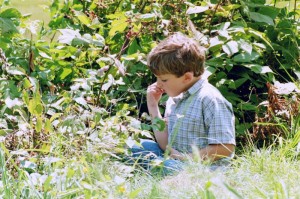We have much more to do and your continued support is needed now more than ever.
Children and Nature: What We Know, What We Are Learning & What We Need To Do
This post is by Mat Duerden, coordinator of Texas A&M University’s Sequor Youth Development Initiative (www.ydi.tamu.edu). Mat received a Ph.D. in Recreation, Park and Tourism Sciences from Texas A&M and a M.S. in Youth and Family Recreation from Brigham Young University. His research focuses on youth development with specific interests in the program evaluations, outdoor recreation, and youth/adult relationships.

My colleagues and I here at Texas A&M University, along with researchers at the University of Tennessee and the National Forest Service, have been collaborating over the last few years to develop and conduct studies to increase our understanding of that relationship.
Specifically, we are interested in more accurately assessing how much time children spend outside. This information will help guide policy and interventions to strengthen the connection between this generation of youth and nature.
In an effort to spread the word about our study efforts and the general topic of connecting youth to nature, I had a chance to sit on a panel with Brigitte Griswold from the Nature Conservancy and Richard Louv from the Children and Nature Network at the American Camp Association National Conference in Atlanta earlier this year. We talked with each other and the audience about research on the relationship between children and nature. I came away with some important insights that I wanted to share with you:
We know a lot about the benefits children experience when they spend time outside.
- There is a rich and growing body of research on children and nature. Connections have been made between children spending time outside and a variety of positive benefits, including increased physical activity, self-discipline, healthy psychological functioning, improved social skills, conservation attitudes and decreased ADHD-related symptoms .
We know enough to act.
- While we as researchers need to continue to strengthen the methodology of our research, as Rich put it during our panel, “we know enough to act.” We have enough evidence that time in nature benefits kids to support efforts to provide as many opportunities in nature as possible.
There is good news about current youth attitudes towards nature.
- A wonderful study recently completed by the Nature Conservancy (PDF) and presented by Brigitte provide some encouraging insights into the relationship between youth and nature. For example, most youth report having an interest in nature. Additionally, many youth feel optimistic about their generation’s ability to serve as positive stewards of the environment. The key appears to be providing youth with meaningful experiences in nature; those who felt they had already had them were much more likely to identify themselves as environmentalists.
It is important that we work harder to understand what’s keeping kids from spending time in nature.
- In order to help youth spend more time outside, we need to understand the barriers keeping them inside. The Nature Conservancy’s study identified a number of such constraints. Top on the list of youth identified constraints were uncomfortable aspects of being outside (e.g., heat, bugs, etc.), lack of transportation to natural areas and lack of nearby natural areas. Additionally, kids who were overweight and obese reported spending less time outside. Across all groups, youth reported spending more time inside involved with media-related activities.
We have learned a lot over the last 20 years about why it is important for children and youth to spend time–not just outside, but in nature. We also know that today’s children and youth are spending less time outside than previous generations. While there are still many unanswered questions, we know enough to act in informed, evidenced-based ways. It is our hope that our NWF Research Consortium will assist in the answering of some these questions and help promote a renewed and strengthened connection between youth and nature.
For more information on Dr. Duerden’s research please visit ydi.tamu.edu.






















